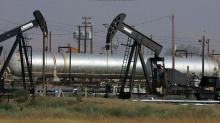Crude oil sees biggest two-day fall since December
 Oil prices fell for a third straight session on Thursday, snapping key technical support after growing talk of a release of strategic petroleum reserves (SPR) by consumer nations spurred profit-taking.
Oil prices fell for a third straight session on Thursday, snapping key technical support after growing talk of a release of strategic petroleum reserves (SPR) by consumer nations spurred profit-taking.Ahead of the end of the quarter, traders took profits from oil’s bull run as the United States, Britain and France consider releasing emergency stockpiles in hopes of bringing down high fuel prices that have caused economic and political fallout.
Concerns about the economy mounted on Thursday after data showed a higher-than-expected number of Americans filed U.S. jobless claims, weighing on stock and crude markets.
“I think part of it is today’s economic data,” said Richard Ilczyszyn, chief market strategist and founder of iitrader.com LLC in Chicago. “I think traders are very sensitive to booking profits to have that 1 to 2 per cent gain for the month.”
“We’ve been talking about the SPR here, France and the UK, that could be weighing on some investors.”
Losses accelerated after U.S. crude broke through the 50-day moving average in afternoon trade, dragging down prices for international benchmark Brent as well.
Brent crude futures fell $1.89 to $122.27 (U.S.) a barrel by 2:34 p.m. ET, extending losses after falling 1.09 per cent the previous session.
U.S. crude futures (CL-FT103.220.440.43%) dropped $2.63 to settle at $102.78 a barrel, having dropped by 1.8 per cent on Wednesday and marking the biggest two-day slide since mid-December. Brent’s premium to U.S. crude rose above $19 a barrel, reaching $19.82 intraday.
Front-month April RBOB gasoline showed more resilience, off only slightly ahead of expiry on Friday.
Brent trading outpaced U.S. crude futures although overall volumes were not strong. Brent crude volumes were 7 per cent below the 30-day moving average in afternoon trade, while U.S. crude trade was 27 per cent below that level.
Despite the run up in prices this year, oil volatility has dropped to the lowest level in five years this month, suggesting that demand for protection against risks including an abrupt loss of Iranian supplies, a dramatic drop in demand or a release of emergency reserves has waned.
RESERVE RELEASE?
In addition to the United States, Britain and France, other countries including South Korea and Japan may join the plan, which comes after prices jumped 15 per cent jump since December.
French Prime Minister Francois Fillon said he believes there is a good chance of a U.S.-Europe accord on the release of strategic oil reserves.
The impact on Iranian supplies from U.S. and EU sanctions aimed at halting Tehran’s nuclear program, an accident in the North Sea and reported attacks on oil-producing areas in South Sudan this week have contributed to the price rise.
The rise in oil prices drew a rare opinion piece in the Financial Times on Wednesday from Saudi Arabia’s oil minister Ali al-Naimi where he reiterated comments from last week that the market was well supplied reassured that the OPEC kingpin would meet any supply loss.
Consumer nations may seek reassurance from Saudi Arabia that it will not cut oil production and neutralise the impact on oil prices if they tap emergency reserves, industry and diplomatic sources said.
Last year after the International Energy Agency tapped reserves at the end of June to fill the gap left by Libya’s civil war, Saudi output at first remained high, and then fell.
Some members of the IEA have argued against the need for another coordinated effort by the agency, although it said in a statement it was ready to respond if market conditions warrant action.
“The oil market has been tightening in recent months,” the IEA said in a statement from its Executive Director Maria van der Hoeven. “The International Energy Agency, like many others, is concerned by the impact of these high prices while the global economic recovery remains fragile.”
You can return to the main Market News page, or press the Back button on your browser.

